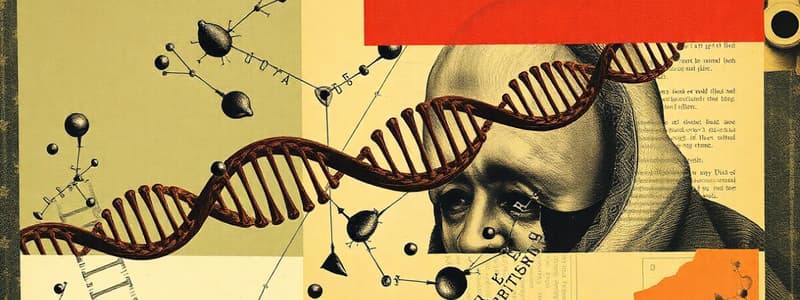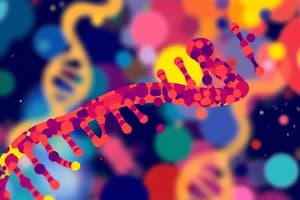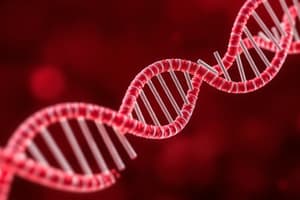Podcast
Questions and Answers
What is the primary function of RNA polymerase during transcription?
What is the primary function of RNA polymerase during transcription?
- To splice introns from mRNA
- To unwind DNA strands
- To synthesize mRNA from the DNA template (correct)
- To attach exons together
What is the role of the 7-methyl Guanosine in post-transcriptional modification?
What is the role of the 7-methyl Guanosine in post-transcriptional modification?
- To initiate RNA replication
- To enhance the stability of mRNA (correct)
- To bind RNA polymerase
- To degrade mRNA strands
During which stage does DNA replication occur?
During which stage does DNA replication occur?
- Before transcription (correct)
- At the end of transcription
- During cell division
- During post-transcriptional modifications
What is the outcome of splicing in mRNA processing?
What is the outcome of splicing in mRNA processing?
Why is it important for mRNA to exit the nucleus?
Why is it important for mRNA to exit the nucleus?
What defines the 'sense' and 'non-sense' strands during transcription?
What defines the 'sense' and 'non-sense' strands during transcription?
What is the central dogma of molecular biology primarily concerned with?
What is the central dogma of molecular biology primarily concerned with?
Flashcards
Central Dogma
Central Dogma
The flow of genetic information from DNA to RNA to protein in cells.
DNA Transcription
DNA Transcription
The process of creating an RNA molecule from a DNA template.
RNA Translation
RNA Translation
The process of synthesizing a protein from an mRNA template.
Gene Expression
Gene Expression
Signup and view all the flashcards
Reverse Transcription
Reverse Transcription
Signup and view all the flashcards
mRNA Processing
mRNA Processing
Signup and view all the flashcards
Cell-Specific Gene Expression
Cell-Specific Gene Expression
Signup and view all the flashcards
Study Notes
Central Dogma of Cytology and Molecular Biology
- DNA transcribes to mRNA; mRNA translates to protein
- DNA remains in the nucleus
- Replication occurs before cell division
- 46 chromosomes (example given)
- Relationship and interaction among the three major molecules involved in inheritance
- Genome (100%)
- Euchromatin (92%)
- Gene Expression
- Transcription to mRNA
Gene Expression
- Occurs within the cell nucleus
- Copying small sequences of mRNA
- Procedure:
- Uncoil DNA using helicase
- RNA polymerase attaches to the DNA to bind and create mRNA
Post-Transcriptional Modifications
- DNA modification after transcription
- Splicing: Joining exons and removing introns
- Polyadenylation: Adding 100-250 adenines
- Capping: Adding GMP + P to GDP + energy
Increased mRNA Lifespan
- Protects mRNA from degradation
- mRNA exits the nucleus through nuclear pores
Studying That Suits You
Use AI to generate personalized quizzes and flashcards to suit your learning preferences.




